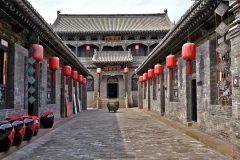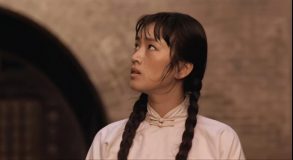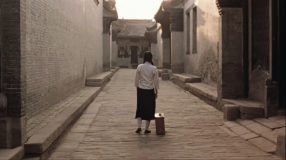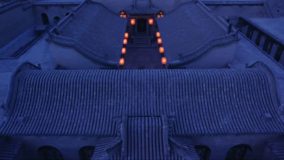RAISE THE RED LANTERN, DIR. ZHANG YIMOU (1991)
Qiao Family Courtyard, Shanxi Province, China

 de
de
Left: The Qiao Family Courtyard in real life. Picture from the search engine ‘Baidu’. Right: The Qiao Family Courtyard in the movie. Scenes from ‘Raise The Red Lantern’ 1991, directed by Zhang Yimou.
Zhang Yimou released Raise The Red Lantern in December 1991. Set in 1920s China, the film used entrenched social and gender to fuel a gorgeously filmed collision between expectations and reality, dreams and despair. The young and beautiful heroine is forced to marry into the Chen’s house (Qiao Family Courtyard) by her greedy mother. As soon as the heroine entered the Chen’s house, she was involved in the infighting among several wives of the house. Finally, she broke down under the pressure of the courtyard and became insane. Qiao Family Courtyard is located in Shanxi Province. The courtyard is a completely enclosed castle-style building complex. Also, it is a national key cultural second-class museum, and an incomparable art treasure house.
In the movie, I find no other eye-catching colors except red and black. The red color fills the whole scene, making audience feel the power of the living life. When it was hung in the courtyard, the red of the lantern clashed with the black of the background, which really brings red is strong and black is miserable. Furthermore, the architectural scenes in the movie are basically symmetrical in composition, with thick courtyard walls on the left, right and above. While in real life, Qiao Family Courtyard in the natural sunlight shine to show full of culture and history. Its exquisite design and fine craftsmanship fully reflect the unique style of Chinese residential buildings in the Qing Dynasty. The sense of magnificent atmosphere is a bit like the ancient Forbidden City and the whole view is warm-toned and very soft.

 When heroine first moved into the Chen’s house. Scenes from ‘Raise The Red Lantern’ 1991, directed by Zhang Yimou.
When heroine first moved into the Chen’s house. Scenes from ‘Raise The Red Lantern’ 1991, directed by Zhang Yimou.
About the use of color, the red face and white clothes of the hero are contrasted with the gray background, The hero represents youth and vitality while the background represents the bleak feudal family. Also, in the panorama of the scene, when the hero is walking on the road, the color is very light and no redundant color, showing the hero’s inner light and confused. Moreover, lantern inside as a symbol of feudal rules, its form itself has gone beyond the connotation of nature into a bondage. In the movie, red is actually a sexual metaphor and a symbol of procreation. About the aesthetics of neat and symmetrical scenes, blood-red lanterns shone on the walls, and the square house was like square coffin and the so-called rules of the feudal patriarchal clan, burying the youth and life of all the women there. Also, in the aerial shot of the eaves of Qiao Family Courtyard, people are squeezed in the bottom of the square building and surrounded, which makes us feel deeply depressed and suffering.

The aerial view of the Qiao Family Building. Scenes from the ‘Raise The Red Lantern’ 1991, directed by Zhang Yimou.
Notes:
1 Produced by the Fu-Sheng Chiu, the film was directed by Zhang Yimou and starred Chinese actor Gong Li. It was written by contemporary Chinese writer Su Tong.The original novel is ‘WIVES AND CONCUBINES’. It was released in China in 1991.
2 The courtyard was built in 1756 AD (the 21st year of The Reign of Emperor Qianlong of the Qing Dynasty) after a villager in Shanxi, Qiao Quanhua, separated from his brother and bought a homestead.
⏤ Yuan Yitong, 3035952525
I appreciate how you tried to link your observations to the film’s themes and effect. You also made good use of references to visual techniques such as composition and colour. You can perhaps collect more virtual fieldwork materials to do a more direct comparison of the space in each scene. For example, could it be possible to use Google Earth to find an aerial photo of the Qiao Family Building similar to the still you selected? You are also reminded to include proper citations of any references used.